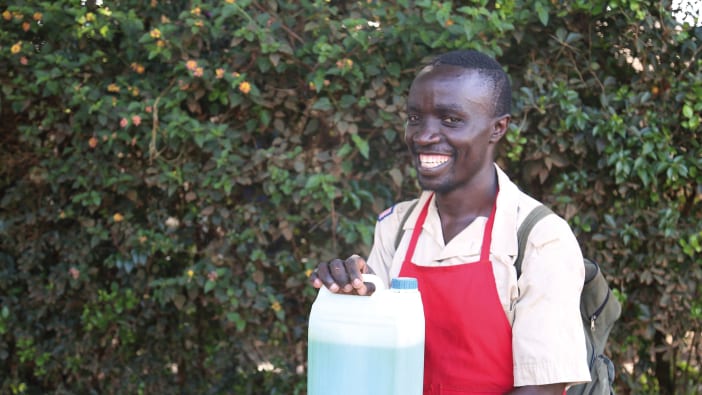Cultivating medicinal plants ensures that they are preserved for your own use and for future generations. Many fruits provide medicine as well as food. These include banana, pineapple, mulberry, passion fruit and pawpaw (papaya). Food plants that also provide medicine include onion, garlic, groundnut, cabbage, chilli, coffee, pumpkin, sunflower, sweet potato, rice, maize, ginger, black pepper and sesame (Sesamum indicum).
Other plants are grown just for their medicinal qualities and are essential in a medicinal garden. The range of plants will vary according to country but may include African marigold (Tagetes erecta), tephrosia (Tephrosia vogelii), vinca (Vinca rosea), thorn apple (Datura stramonium), annato tree, (Bixa orellana), tithonia (Tithonia diversifolia) and African malve (Hibiscus sabdariffa). Make sure that overenthusiastic collection does not mean these plants die out in the wild.
Contour hedges
Before you plant medicinal plants, plant hedges along the contour lines to prevent soil erosion, fertilise the soil, and provide shade. The lines should be 2–4 metres apart on sloping ground and 5 metres apart on level ground. Useful species include…
- lemon grass (Cymbopogon citratus), a medicinal plant
- leucaena (Leucaena leucocephala) a legume which improves soil fertility
- Cassia spectabilis which grows readily from metre-long cuttings
- pigeon pea (Cajanus cajan)
- moringa (Moringa oleifera) which produces edible leaves and beans which are rich in protein, vitamins and minerals.
Every year at the start of the rainy season, trim the hedges back to a height of about one metre, and work the leaves into the soil.
Trees
Plant fruit trees round the edges or alongside the garden. Depending on the soil, climate and altitude, include mango, tamarind, orange, papaya, guava and avocado trees. All these fruits are rich in vitamins A and C.
Plant neem trees if the climate allows. They have many medicinal, insecticidal and other properties. They grow well, even in dry climates.
Planting methods
If possible, make two gardens – a demonstration garden and a production garden. For the production garden, it is useful to establish a nursery to propagate seeds and small cuttings. It is better to sow in alternate lines or to mix up the various medicinal plants, as they would grow in the wild. In this way the plants provide shade for each other, and it is possible to reap a harvest in the dry season as well.
Learn from experience whether the plants grow best in full sun or in the shade, and whether they need a lot of water or a little. Observe carefully where they seem to flourish in the wild.
Demonstration garden
Set aside a small area as a demonstration garden which you can use for teaching purposes with medical staff, traditional healers, school children and teachers. Plant examples of each plant known to be used in traditional medicine. Place this garden near the road – for example near the entrance to a clinic or hospital – so everyone who passes can see it.
Label your plants
In the demonstration garden, give each plant a label, on which you write both the local name, the scientific name and its uses. Old iron sheets and plastic buckets can be cut up to make useful permanent labels. Write with a permanent marker. The scientific name is important, as visitors from another country – or maybe even from the next village – may call plants by quite different local names.
Information provided by Dr Keith Lindsey and Dr Hans-Martin Hirt of Anamed, Schafweide 77, 71364 Winnenden, Germany.









